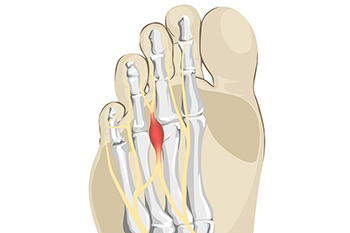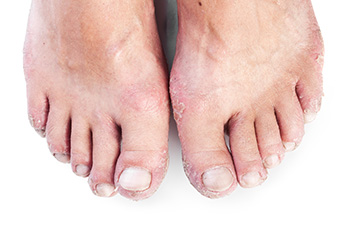Items filtered by date: December 2023
Recognizing Common Symptoms of Morton’s Neuroma

Morton's neuroma, a nerve disorder affecting the feet, brings forth a unique set of symptoms that can disrupt daily life. Characterized by the thickening of tissues around a nerve leading to the toes, this condition commonly presents as a sharp, burning pain in the ball of the foot. Individuals with Morton's neuroma may feel as if they are standing on a pebble or a fold in their sock. This discomfort often radiates into the toes, causing tingling or numbness. The pain tends to worsen with prolonged weight-bearing activities, such as walking or standing. Wearing tight shoes exacerbates symptoms, making proper footwear selection vital for those affected. It is not uncommon for individuals with Morton's neuroma to experience a feeling of relief when they remove their shoes. If you have one or more of the above symptoms, it is suggested that you speak with a podiatrist who can accurately diagnose and treat Morton’s neuroma.
Morton’s neuroma is a very uncomfortable condition to live with. If you think you have Morton’s neuroma, contact Darren Day, DPM of Hawaii. Our doctor will attend to all of your foot care needs and answer any of your related questions.
Morton’s Neuroma
Morton's neuroma is a painful foot condition that commonly affects the areas between the second and third or third and fourth toe, although other areas of the foot are also susceptible. Morton’s neuroma is caused by an inflamed nerve in the foot that is being squeezed and aggravated by surrounding bones.
What Increases the Chances of Having Morton’s Neuroma?
- Ill-fitting high heels or shoes that add pressure to the toe or foot
- Jogging, running or any sport that involves constant impact to the foot
- Flat feet, bunions, and any other foot deformities
Morton’s neuroma is a very treatable condition. Orthotics and shoe inserts can often be used to alleviate the pain on the forefront of the feet. In more severe cases, corticosteroids can also be prescribed. In order to figure out the best treatment for your neuroma, it’s recommended to seek the care of a podiatrist who can diagnose your condition and provide different treatment options.
If you have any questions, please feel free to contact our offices located in Honolulu and Kahuku, HI . We offer the newest diagnostic and treatment technologies for all your foot care needs.
The Effects of Psoriatic Arthritis on the Feet and Ankles

Psoriasis is a visible autoimmune disease characterized by red patches of skin with silvery scales. It results from an overactive immune system, attacking healthy tissue and causing excess skin cell production. However, this immune response can also trigger inflammation in joints. Approximately one-third of psoriasis patients develop psoriatic arthritis, or PsA, a chronic inflammatory joint disease. Often, psoriasis precedes PsA, but joint issues can emerge before skin symptoms, or may be so mild that patients do not connect them with psoriasis. Psoriatic arthritis can affect any joint, including the ankles and tendons around them. Symptoms include pain, tenderness, swelling, and warmth in the joints. Foot-related problems from PsA can include swelling of entire toes, heel pain from Achilles' tendon inflammation, and sole pain due to plantar fascia inflammation. Additionally, it can cause nail changes such as lifting, pitting, discoloration, or thickening. Managing PsA involves symptom control and joint protection. If you have psoriatic arthritis and it is impacting the comfort of your feet or ankles, it is suggested that you schedule an appointment with a podiatrist for a correct diagnosis and treatment options.
Arthritis can be a difficult condition to live with. If you are seeking treatment, contact Darren Day, DPM from Hawaii. Our doctor can provide the care you need to keep you pain-free and on your feet.
Arthritic Foot Care
Arthritis is a term that is commonly used to describe joint pain. The condition itself can occur to anyone of any age, race, or gender, and there are over 100 types of it. Nevertheless, arthritis is more commonly found in women compared to men, and it is also more prevalent in those who are overweight. The causes of arthritis vary depending on which type of arthritis you have. Osteoarthritis for example, is often caused by injury, while rheumatoid arthritis is caused by a misdirected immune system.
Symptoms
- Swelling
- Pain
- Stiffness
- Decreased Range of Motion
Arthritic symptoms range in severity, and they may come and go. Some symptoms stay the same for several years but could potentially get worse with time. Severe cases of arthritis can prevent its sufferers from performing daily activities and make walking difficult.
Risk Factors
- Occupation – Occupations requiring repetitive knee movements have been linked to osteoarthritis
- Obesity – Excess weight can contribute to osteoarthritis development
- Infection – Microbial agents can infect the joints and trigger arthritis
- Joint Injuries – Damage to joints may lead to osteoarthritis
- Age – Risk increases with age
- Gender –Most types are more common in women
- Genetics – Arthritis can be hereditary
If you suspect your arthritis is affecting your feet, it is crucial that you see a podiatrist immediately. Your doctor will be able to address your specific case and help you decide which treatment method is best for you.
If you have any questions, please feel free to contact our offices located in Honolulu and Kahuku, HI . We offer the newest diagnostic and treatment technologies for all your foot care needs.
Anatomy of Foot Stress Fractures

Stress fractures are tiny cracks in bones, often seen in the feet due to repetitive stress. Two main types of these fractures exist, consisting of fatigue fractures from overuse and insufficiency fractures in weakened bones. Common in weight-bearing bones like the metatarsals, these fractures result from activities like running and jumping. Symptoms can include localized foot pain and swelling. Diagnosis through imaging is essential. Relief involves rest, reducing impact on the feet, and sometimes using supportive devices, such as crutches or braces. If you have endured a foot stress fracture, it is suggested that you visit a podiatrist who can accurately diagnose and treat this condition.
Stress fractures occur when there is a tiny crack within a bone. To learn more, contact Darren Day, DPM from Hawaii. Our doctor can provide the care you need to keep you pain free and on your feet.
How Are They Caused?
Stress fractures are the result of repetitive force being placed on the bone. Since the lower leg and feet often carry most of the body’s weight, stress fractures are likely to occur in these areas. If you rush into a new exercise, you are more likely to develop a stress fracture since you are starting too much, too soon. Pain resulting from stress fractures may go unnoticed at first, however it may start to worsen over time.
Risk Factors
- Gender – They are more commonly found in women compared to men.
- Foot Problems – People with unusual arches in their feet are more likely to develop stress fractures.
- Certain Sports – Dancers, gymnasts, tennis players, runners, and basketball players are more likely to develop stress fractures.
- Lack of Nutrients – A lack of vitamin D and calcium may weaken the bones and make you more prone to stress fractures
- Weak Bones – Osteoporosis can weaken the bones therefore resulting in stress fractures
Stress fractures do not always heal properly, so it is important that you seek help from a podiatrist if you suspect you may have one. Ignoring your stress fracture may cause it to worsen, and you may develop chronic pain as well as additional fractures.
If you have any questions, please feel free to contact our offices located in Honolulu and Kahuku, HI . We offer the newest diagnostic and treatment technologies for all your foot care needs.
Arthritis Can Cause Pain in the Feet and Ankles
Causes and Definition of Tarsal Tunnel Syndrome

Tarsal tunnel syndrome, a condition affecting the inner ankle and foot, arises from compression of the tibial nerve within the tarsal tunnel. This tunnel, enclosed by bone and soft tissues, houses nerves, arteries, and tendons. When pressure on the tibial nerve increases, it can result in tarsal tunnel syndrome. Causes vary, with one primary factor being overuse, leading to inflammation and swelling within the tunnel. Flat feet or conditions altering foot biomechanics may contribute by narrowing the tunnel and compressing the nerve. Ankle injuries, cysts, or tumors within the tunnel can exacerbate the compression, as can systemic conditions like diabetes or arthritis. Symptoms encompass tingling, burning sensations, and pain radiating to the arch, heel, or toes. Recognizing these indicators and understanding the diverse causes of tarsal tunnel syndrome is vital for timely intervention. If you have foot pain, it is strongly suggested that you schedule an appointment with a podiatrist who can diagnose and treat tarsal tunnel syndrome.
Tarsal tunnel syndrome can be very uncomfortable to live with. If you are experiencing tarsal tunnel syndrome, contact Darren Day, DPM of Hawaii. Our doctor can provide the care you need to keep you pain-free and on your feet.
Tarsal Tunnel Syndrome
Tarsal tunnel syndrome, which can also be called tibial nerve dysfunction, is an uncommon condition of misfiring peripheral nerves in the foot. The tibial nerve is the peripheral nerve in the leg responsible for sensation and movement of the foot and calf muscles. In tarsal tunnel syndrome, the tibial nerve is damaged, causing problems with movement and feeling in the foot of the affected leg.
Common Cause of Tarsal Tunnel Syndrome
- Involves pressure or an injury, direct pressure on the tibial nerve for an extended period of time, sometimes caused by other body structures close by or near the knee.
- Diseases that damage nerves, including diabetes, may cause tarsal tunnel syndrome.
- At times, tarsal tunnel syndrome can appear without an obvious cause in some cases.
The Effects of Tarsal Tunnel Syndrome
- Different sensations, an afflicted person may experience pain, tingling, burning or other unusual sensations in the foot of the affected leg.
- The foot muscles, toes and ankle become weaker, and curling your toes or flexing your foot can become difficult.
- If condition worsens, infections and ulcers may develop on the foot that is experiencing the syndrome.
A physical exam of the leg can help identify the presence of tarsal tunnel syndrome. Medical tests, such as a nerve biopsy, are also used to diagnose the condition. Patients may receive physical therapy and prescriptive medication. In extreme cases, some may require surgery.
If you have any questions please feel free to contact our offices located in Honolulu and Kahuku, HI . We offer the newest diagnostic and treatment technologies for all your foot and ankle needs.






